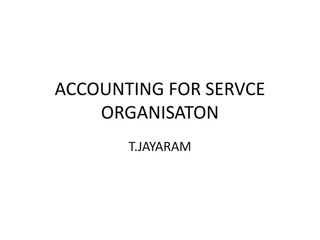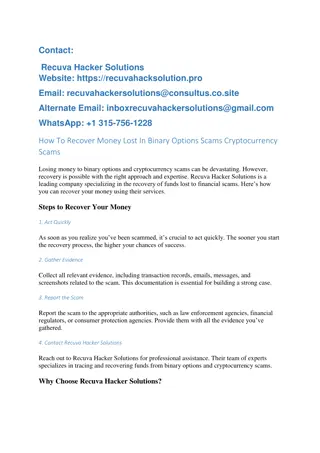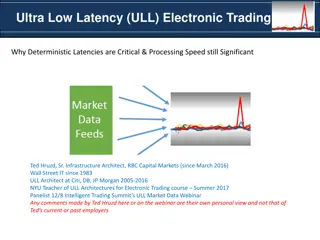
Second-Hand Trading Web Service Platform
Provide a reliable platform for second-hand product trading with a clean user interface. Emphasizing fault tolerance, scalability, and efficiency by modularizing services across servers. Interacting intelligently with AWS S3 for enhanced search capabilities. Backup systems and smart database interactions ensure high performance for a seamless trading experience.
Download Presentation

Please find below an Image/Link to download the presentation.
The content on the website is provided AS IS for your information and personal use only. It may not be sold, licensed, or shared on other websites without obtaining consent from the author. If you encounter any issues during the download, it is possible that the publisher has removed the file from their server.
You are allowed to download the files provided on this website for personal or commercial use, subject to the condition that they are used lawfully. All files are the property of their respective owners.
The content on the website is provided AS IS for your information and personal use only. It may not be sold, licensed, or shared on other websites without obtaining consent from the author.
E N D
Presentation Transcript
Second-hand Trading Web Service Group Member: Jingwei Hao Xiaofeng Yuan Yanjun Liu
Motivation & Goals Provide a platform for convenient second-hand product trading Design clean and direct user interface easy to use Considering large amount of potential users, the web service should be fault tolerant, scalable and efficient Modularize functions as independent service in different servers for better performance, e.g. search, account and item management, etc. Interact with AWS S3 smartly not naively, make the searching intelligent through pre-defined logic, analysis and learning techniques Goals: Allocate service in various server thus achieve high scalability and trigger them through load balancing techniques to realize efficiency. Backup servers of fault tolerance to ensure stability. Interact with database smartly for better performance. Make a comprehensively well- functioning second-hand trade web service and make trading second-hand products easier.
Related Work Pull-based Load Balancing Using a Messaging and Queuing Unit - Colyer, Adrian Mark. "High- availability WWW computer server system with pull-based load balancing using a messaging and queuing unit in front of back-end servers." Load Balancing Algorithms: Random, Round Robin, Weighted Round Robin, Least Connection, Weighted Least Connection - http://www.jscape.com/blog/load-balancing-algorithms & Jyoti Vashistha, Anant Kumar Jayswal. Comparative Study of Load Balancing Algorithms. AWS web service are in wide usage, in which S3 is a popular file based database and people use buckets and objects to store and manage their data items, e.g AWS build in filter Prefix - Amazon Simple Storage Service Developer Guide API Version 2006-03-01. Various searching methods in the field. Lots rely on fuzzy search to get the needed data. Levenshtein Distance is one algorithm based on dynamical programming and string match - https://en.wikipedia.org/wiki/Levenshtein_distance There exist several web service framework among which CXF is a widely used one providing front end programming and supports different transports and data bindings - Apache CXF Web Service Development. ISBN 978-1-847195-40-1.
System Design Specifics - Architecture Servic e Balancer Backup Client Servic e S3 Cloud Balancer Backup Client Balancer Servic e Client Balancer Backup Balancer and Service are all web services based on CXF, use SOAP protocol for exchanging XML-based messages. S3: Item Bucket --- Objects: Category/Item/ID with content: id, info, price, imgpath, sellername, sellertel Person Bucket --- Objects: Name/Tel with Objects: Category/Item/ID
Testing &Evaluation Fault Tolerance Take random strategy to select a backup to do the balancing work in case the balancer crashes. If services fail, the system is able to call available one according to the load balancing strategy. Load Balancing 1. Random strategy 2. Least Connections strategy Take the number of current connections each server has into consideration. Every time, we assign the new client request to the server with the least number of connections. 1. Least Load strategy Estimate the task load and keep the current task load each server has. Every time, we assign the new client task to the server with the least load. Evaluate performance: With certain # of servers, how the mean response time changes as the requests arrival rate increases

![Guardians of Collection Enhancing Your Trading Card Experience with the Explorer Sleeve Bundle [4-pack]](/thumb/3698/guardians-of-collection-enhancing-your-trading-card-experience-with-the-explorer-sleeve-bundle-4-pack.jpg)




















